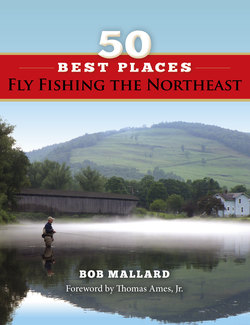Читать книгу 50 Best Places Fly Fishing the Northeast - Bob Mallard - Страница 11
На сайте Литреса книга снята с продажи.
ОглавлениеForeword
WHY THE HECK should anyone pay the least bit of attention to one man’s selection of the 50 best places to cast a fly in the Northeast? To answer that question, let me sketch you a portrait of the man behind the list. He is opinionated. He is impatient. He is painfully organized. But he is so well informed that he can courageously argue both sides of a question with equal conviction. He is a man I can trust to be good to his word and to be fully prepared for what lies ahead. If you are planning to spend your precious time and hard-earned money traveling to the destinations described in this book, you are going to want to trust Bob Mallard the way I do.
I have always figured that the best way to catch fish was to study and imitate the foods that they eat. Bob’s flair for fly fishing comes from an understanding of something even more fundamental and, quite literally, deeper. He knows fish—especially trout. He knows where they will be, how they will behave under a given condition, how they will respond to changing conditions, and how they will react when presented with a fly. This is not easy knowledge to come by. I can study trout foods—mostly insects—in an aquarium or streamside, but what actually results in fish getting hooked begins deep under the water’s surface where most of us can’t see it. That’s why Bob pulls fish out of places where most of us would not bother casting a line, using flies that match-the-hatch purists like me do not even carry.
The kind of fish sense that Bob possesses comes only from time on the water. He spends more time with a fly rod in his hand than anyone I know. I used to wonder how he could devote himself so single-mindedly and whole-heartedly to fishing until I realized that he treasures each fish hooked as a lesson in angling learned. Bob has caught some big lessons, and a lot of them, but has yet to satisfy either his appetite or his capacity for knowledge. We’ve fished together every year for at least the last dozen, and I’ll begrudgingly admit to having learned a lot more from Bob than he has learned from me. He has shared what he has learned freely, and with all of the tenderness of a defensive tackle.
Bob has both an uncanny knack for choosing the right fly and a practiced and polished delivery, but when a trout chooses to ignore his fly, Bob will not waste too much time trying
to change its mind with minor changes in pattern or presentation. He will make a radical change or simply move on to the next fish and then return the next hour, the next day, or the next year with a whole new strategy for capturing the missed one. Bob doesn’t wait for things to happen, he makes them happen.
In his second life as a fly-shop owner, Bob applies the same painstaking attention to minutiae that brought him success in a career in information technology. He scrutinizes every piece of fishing tackle, every stitch and seam on a vest and pair of waders, every fly rod, line, and pattern, with the idea that landing the fish of a lifetime will ultimately depend on the performance of his gear. If an item is flawed, poorly designed, poorly manufactured, or otherwise substandard in any way, he will not sell it to a customer, and he certainly will not get caught using it himself.
Bob has chosen both the waters and the writers for this book with the same exacting standards. No starry-eyed romanticism, no nod to nostalgia for the sake of nostalgia, has clouded his judgment in making his selections. No storied past in and of itself will earn a river or stream a place in this book if it is flawed or substandard and can no longer support a healthy fishery. If it is accessible, well-regulated, and well-maintained, it probably made the cut. If it is deficient in any of these qualities, he will not waste his time, or yours, by including it.
Just think: if you live in the Northeast you will never have to sit in another crowded airline seat to get to a fishing destination. If you made a list of the great waters you have fished in your lifetime, would there be fifty? Here are fifty great fisheries you can visit within a day’s drive of home. Here, too, are the resources you will need to make your trip worthwhile, including tips about where to and how to fish them, by expert anglers who know the water.
—THOMAS AMES, JR.
Thomas Ames, Jr. is the author of Hatch Guide for New England Streams, Fishbugs, Caddisflies: A Guide to Eastern Species for Anglers and Other Naturalists, and numerous articles on fly fishing.
